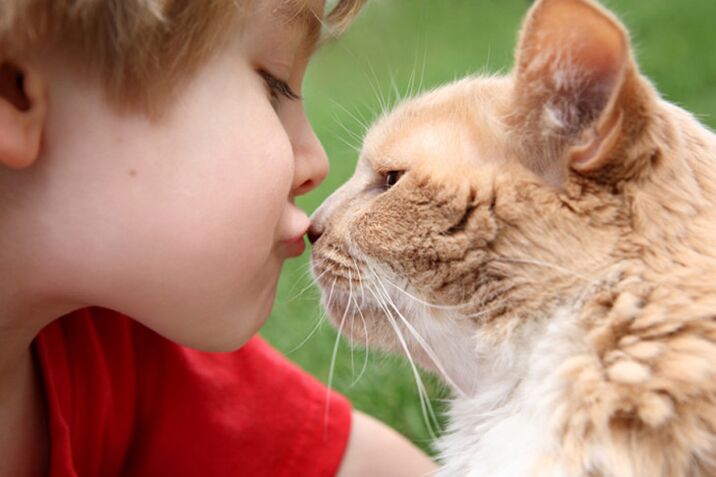
Why is helminthiasis dangerous?
Most helminthiases of the species most commonly found in children parasitize in the intestines. In it they live and feed, as a result of which they reproduce and release toxins. Parasitic worms also mechanically affect the intestinal walls. The consequence of the active life of worms in a child's body can be:
- Avitaminosis and weight loss. These problems arise due to the lack of nutrients and vitamins. As a result, children begin to lag behind in development. Pathological processes can start in other organs.
- Intestinal inflammation, colitis, dysbacteriosis, bleeding. All these unpleasant and serious complications are caused by mechanical damage caused by worms in children's body.
- The development of inflammatory processes in the appendix, liver, gall bladder. These are organs adjacent to the intestines in which parasites can move.
- Intestinal obstruction. It can be partial or complete and sometimes there is a risk of rupture of the intestinal wall.
- intoxication of the body. When worms live and die inside a person, they release aggressive toxins.
- Allergy. The remains of parasites are considered strong allergens.
- Violation of liver function. For this reason, the child must follow a diet for many years and also consume enzymes.
- Psychosis. Helminths tend to have a negative impact on the patient's nervous system.
Types of worms affecting the body of a child
There are many types of parasites that can appear in a child's body. They vary in size, being small and large, and also manifest in different ways and have a different incubation period, which varies from 1-1. 5 months. To prescribe effective drugs that will help cure helminthiasis, you need to correctly determine their type. The most common types in children are:
- Tape. This type of worm includes cestodes, pygmy tapeworms, tapeworms and echinococcus.
- Ringed. Among them are annelids.
- Round. Their representatives are trichinella, pinworms, whipworms, nematodes, roundworms.
- With thorns. They are represented by scrapers.
- Flat. Among them are trematodes and flux.
Causes and methods of infection
It is possible to get infected with helminthiasis not only in an exotic country or by trying an unusual dish on the menu. Sandbox play and unwashed hands are the easiest way for worms to enter the child's body. Young children tend to touch and study everything, without thinking about the purity of the subject being studied. After that, they can safely lick their fingers without washing them first. Worms remain viable for a very long time (from weeks to months), remaining on the surface of various objects.
In addition to dirty hands, the main sources of infection include:
- dirty toys and surfaces;
- clothes;
- shoes;
- railing at the entrance;
- door handles;
- raw water;
- dirty vegetables and fruits;
- soil, soil, sand;
- contact with a sick child;
- insufficiently prepared meat;
- poorly thermally processed fish or other seafood.
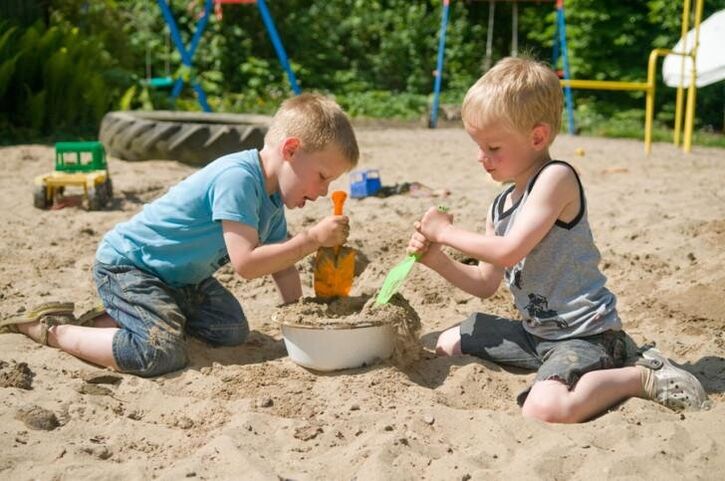
Symptoms of the presence of parasites in children
Usually, in children under 1 year of age, any manifestation of the presence of parasites in the body is observed in isolated cases. The first symptoms that signal an infection with helminths are already registered at an older age (about 2-3 years) in children who attend a kindergarten or other developmental organizations.
Helminthiases in children are represented by a large variety, and each individual type has its own specific characteristics. However, there are a number of symptoms that are characteristic of each type of worm:
- irritability and moodiness for no apparent reason;
- restless sleep;
- allergies;
- itching in the anus;
- increased secretion of saliva;
- disturbed digestion, accompanied by diarrhea, constipation, nausea and flatulence;
- lack of appetite;
- weight loss with good food;
- pale skin.
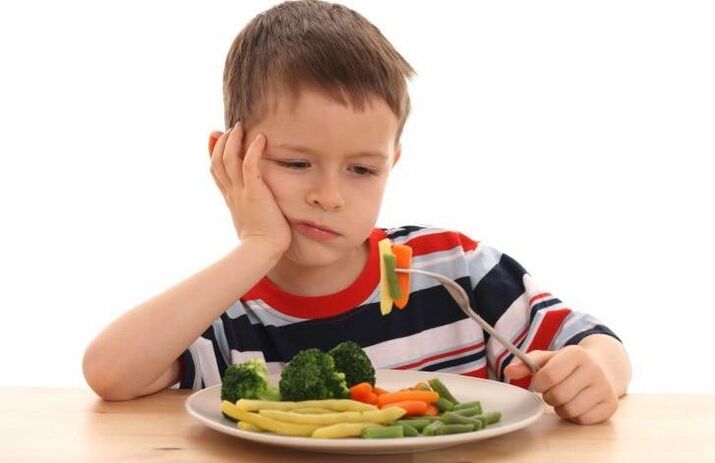
In older children, these symptoms may include:
- headache;
- stomach discomfort;
- dizziness;
- increased fatigue;
- poor concentration.
Enterobiasis (leg worms)
The disease when parasites such as tapeworms enter the child's body is called enterobiasis. This type of helminth is one of the most common in young children of preschool age - from 2 to 5 years old. They vary in average size, which is 5-13 mm, and minimal damage compared to other types of parasites.
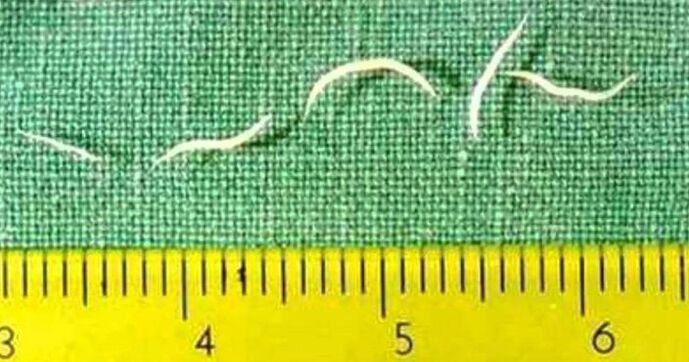
Their presence causes the following symptoms:
- Strong itching in the anus. Its intensity can reach such strength that the child will not sleep well, scratching the anus, causing irritation and inflammation.
- Urinary incontinence during night sleep. Seen in girls. This happens if worms from the anus enter the urethra. As a result, the baby begins to develop urethra, vagina or cyst.
Worms are easy to get rid of and are not as dangerous as other types of worms. It is important in time, when the first signs appear, to consult a doctor and undergo the necessary tests. If pinworms were found in a child, then the parents also need treatment. All clothes, towels and other cloths should be washed and ironed, and the room washed thoroughly, as the eggs of these worms are found on all surfaces in the home of the infected person.
Ascariasis (roundworm)
The second most common in children are roundworms of large sizes up to 40 cm, living in the small intestine - roundworms. In addition to the general symptoms of helminthiasis, in the case of ascaris, a person infected in the initial stage develops an unreasonable cough in the absence of any inflammatory process in the respiratory tract. Its appearance is due to the fact that the larvae of this type of parasite enter the lungs and upper respiratory tract and re-enter the stomach through coughing.
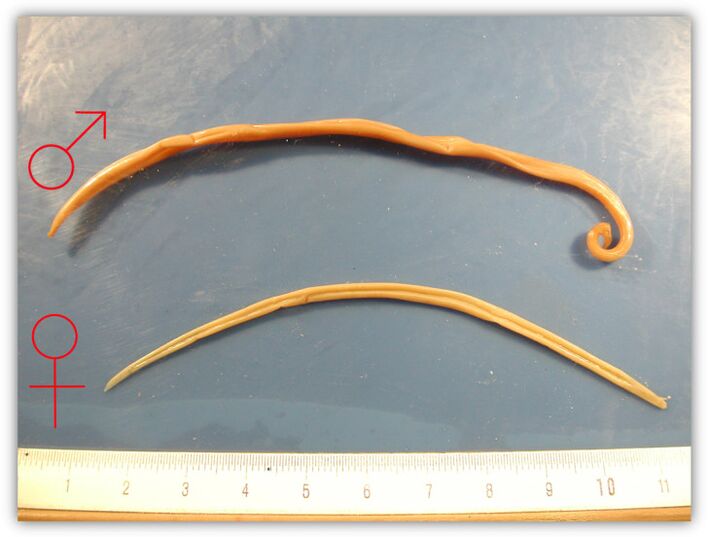
Other characteristic features include:
- headache and dizziness;
- allergies;
- enlarged lymph nodes;
- elevated temperature;
- intestinal disorders.
At the same time, the itching in the buttocks with roundworms is absent. Not only the intestines, but also any other organ or system of the body can become a habitat.
Trichuriasis (head mustache)
These parasites in children are worms with very thin bodies, the length of which reaches 5 cm. The female whipworm can lay up to 2, 000 eggs at a time. Usually, such helminths are more common in adolescence, and in young children they appear much less often.
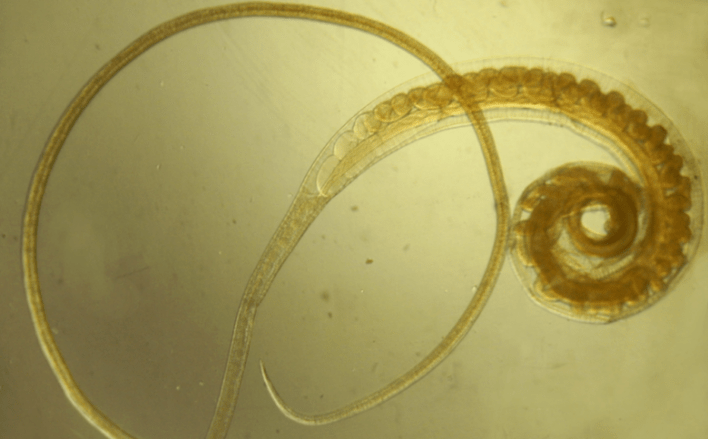
A distinctive feature of trichuriasis is the almost complete absence of any signs of helminthic invasion. Possible symptoms include:
- disturbances in the work of the nervous system (irritability, headache);
- problems with the digestive system, accompanied by diarrhea, nausea or vomiting;
- increase in body temperature.
Signs of other parasites
Among other types of worms that can appear in children, the following can be distinguished:
- Hymenolepiasis or pygmy mouse stripe. He has no specific symptoms. Its presence can be recognized by nausea, loss of appetite, heartburn, diarrhea and constipation, headache, abdominal pain, increased salivation, dizziness, fatigue, skin rash, allergic rhinitis and bronchospasm.
- Opisthorchiasis or Siberian tick of the cat. These worms in a child cause subfebrile fever, rash on the skin, swelling of the lymph nodes, pain in the joints and right hypochondrium, pancreatitis, gastritis and other signs of digestive tract dysfunction, chronic catarrhal syndrome, etc.
- Toxocariasis. It is transmitted through animals. The main symptoms are an allergic cough with suffocation and skin rashes, which are characterized by severe itching.
- Wide ribbon. The source of infection is not fried or undercooked fish. Symptoms include abdominal pain, an allergic reaction, B12 deficiency anemia, and other common signs of an intestinal disorder.
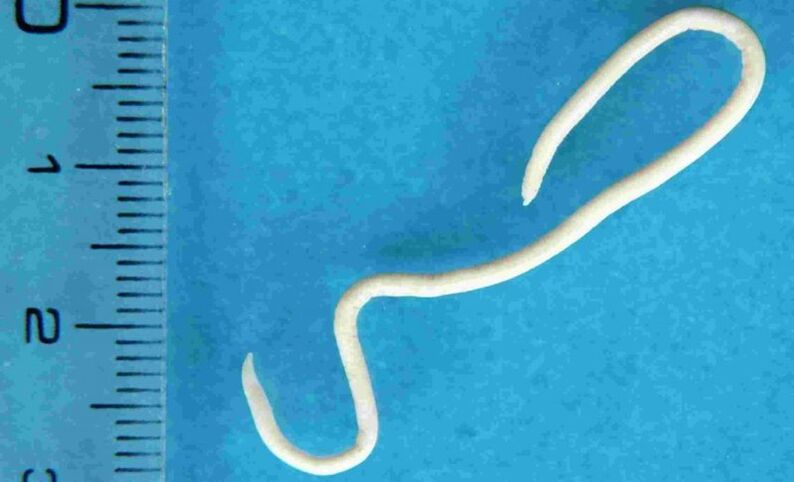
How to check if your child has worms?
In most cases, it is difficult for parents to associate specific symptoms with helminthiasis or to understand why a child suddenly has vomiting or other symptoms for no apparent reason. At the slightest suspicion of the appearance of worms, you should go to specialists and do tests, which make it easy to check the assumption of helminthic invasion. It will not take much time and effort, but the reason for the baby's illness will be exactly clear, and it will be possible to carry out treatment in a timely manner.
Self-diagnosis
Self-diagnosis is a careful monitoring of changes in the behavior, development, habits, routine and normal state of the child - both physical and emotional-psychological.
It includes:
- periodic examination of feces for the presence of worms;
- monitoring the frequency of toilet visits;
- examining the skin for redness, rash or irritation;
- controlling the amount of food consumed.
Testing
Medical diagnosis is necessary to confirm the diagnosis if worms are detected visually, or only if a helminthic invasion is suspected. To find out the cause of the symptoms, you need to do a series of tests, which include:
- Fecal analysis. In it, you can find eggs or parts of already matured worms. The effectiveness of the method is maximum during the period when there are already mature individuals in the intestine, d. m. th. approximately 3 weeks to a month after infection. Fecal material should be collected in the morning and sent to the laboratory.
- A spot or itching from the anus. To do this, use a dry cotton swab dipped in glycerin or adhesive tape. The analysis allows you to identify the larvae of worms that were deposited in the skin areas in the anus.
- General blood analysis. Patients with blood helminthiasis may have an increased number of immune cells, a high erythrocyte sedimentation rate and a reduced hemoglobin level.
- ELISA blood test. It allows you to detect parasites at an early stage with the help of staining enzymes that attract worms, viruses and other foreign bodies.
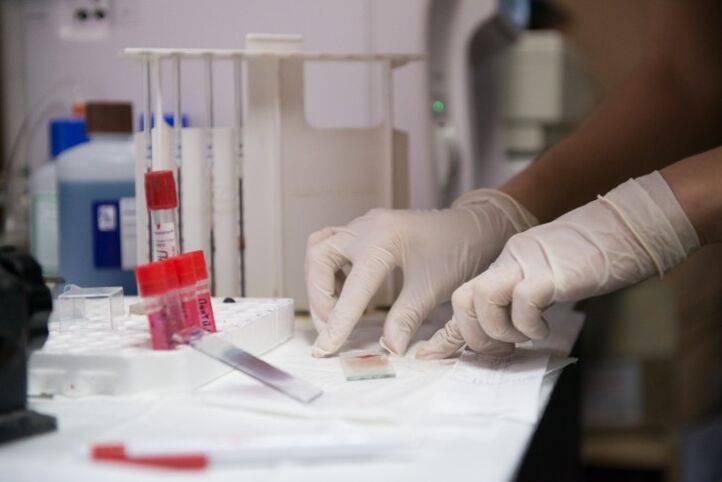
Additional tests for parasites in a child that may be done in an outpatient setting include:
- analysis for the presence of IgG antibodies;
- ultrasound procedures;
- X-Ray.
Features of drug treatment
The appointment of drugs to combat parasites in a child should be taken by a doctor after passing all the necessary tests and making an accurate diagnosis and the type of worms. Among the most common drugs against helminthic invasion, it should be noted:
- Anthelmintic drug acting on nematodes. Admission is allowed from 6 months. Effective against all types of roundworms, but useless against flatworms.
- Anthelmintic medication of the benzimidazole group. Appointed from 2-3 years. The dose is determined at 10 mg per kilogram of body weight.
- Antiprotozoal and antimicrobial drug from the group of nitroimidazoles. Suitable for any age according to which the daily dose is determined.
- An anthelmintic drug of the benzimidazole group. For children from 2 years old against roundworms.
What folk remedies can help?
In addition to medications, worms can be treated with folk remedies.
The most popular products that can provide effective treatment for worms in children are:
- Garlic. It successfully destroys roundworms, tapeworms, pinworms and copes with many other types of parasites. Suitable for children from 5 years old and with a healthy stomach. 1 clove should be given before meals once a day. It can be taken with water or milk. Garlic is also an excellent antiviral agent.
- Pumpkin seeds. They should be eaten on an empty stomach and raw. Children usually like this treatment. Alternatively, they can be crushed and mixed with honey if the child is not allergic to honey.
- Sagebrush. Allowed for children from 12 years old. To simplify the reception, it should be mixed with a piece of bread and salt.
- Fresh carrot juice. Half a cup on an empty stomach once a day for 7-10 days is enough. You can also ingest raw carrots.
- Beet juice. It is given on an empty stomach. It is advisable to alternate it with carrots, so as not to provoke stool violations.
- Nuts. A few pieces a day will be enough for a child.
- A pineapple. Fresh and not canned fruit is a delicious and effective remedy.
- citrus fruits. In their "company" you can add berries and fruits with a sour taste.
prevention
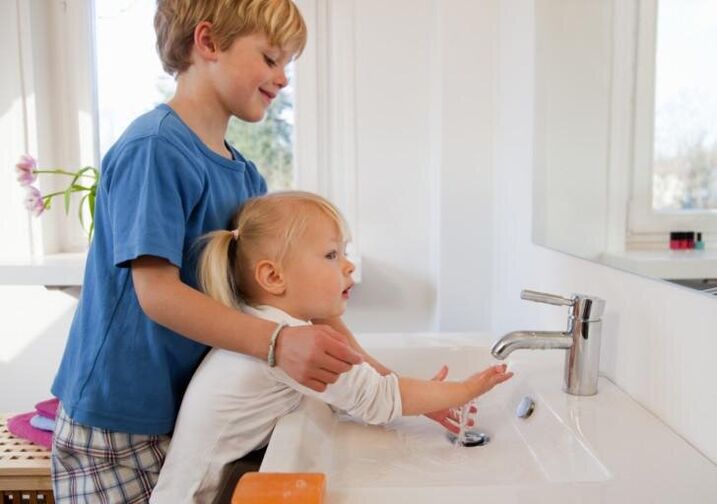
Regardless of the type of worms, prevention comes down to observing the basic rules of personal hygiene:
- Washed food. All vegetables, fruits and berries should be washed well before eating. As an additional measure, the products can be wetted with boiling water.
- Clean hands. You should wash them before eating, after walking, visiting the hospital and standing in public places, after going to the toilet and playing with animals, even pets.
- Deworming of pets. It should be done at least 2 times a year.
- Boiled or filtered water for drinking. Drinking water from open reservoirs is prohibited. Swimming in them should also be avoided to prevent splashing water from entering the mouth. Salt lakes and seas are an exception.
- Regular prevention with the help of folk remedies.
- Caring for old and new toys. Soft toys should be washed periodically, plastic and plastic ones should be washed with boiled water. The new ones, before they are given to a child, must be poured with boiling water without fail.
- No bugs! Flies, mosquitoes, cockroaches carry helminth eggs in their paws. It is important to prevent them from entering the house. To do this, you can use fumigators, adhesive tapes and special crayons.
- Exclusion from the child's diet of fish and meat foods that require low cooking of animal products.
- Stool analysis once a year. This procedure will help detect worms at an early stage.
















































